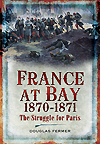
France at Bay, 1870–1871: The Struggle for Paris, by Douglas Fermer, Pen and Sword Books, Barnsley, United Kingdom, 2011, $39.95
France at Bay, Douglas Fermer’s second volume on the Franco-Prussian War, takes up the eclipse of France following Napoléon III’s surrender at Sedan on Sept. 2, 1870. Upon reaching Paris, news of the emperor’s capitulation prompted the overthrow of the Second Empire and the formation of the provisional Government of National Defense. The author describes, step by step, the military reorganization of a new French army by the republican government. The architects of that resurgence were Léon Gambetta, a statesman of Italian origin from the city of Nice, and his deputy, Charles de Freycinet, an engineering genius.
Between September 1870 and the end of January 1871 the duo created a dozen new army corps, numbered from XV to XXVI, theoretically mustering more than 900,000 troops to continue prosecuting the war outside Paris. To supply the new army, Gambetta looked to the huge stacks of weapons left in the United States after the Civil War. To cover the cost, he arranged in London with American banker J. Pierpont Morgan a loan of 250 million Francs at an interest rate of 7 percent. His faith in the citizenry was reflected in his rapid development of national guard battalions.
In Paris the results of these efforts were different from what was expected. Reading the book, the reader may well wonder how a garrison of more than 600,000 soldiers—ringed by a network of fortresses, with ample supplies of food, superiority in heavy artillery and a war industry to produce ammunition and cannon for its defense—could allow itself to be encircled by an army less than a third its size. One explanation is that the officers in charge of Paris had different political beliefs than those of Gambetta and the members of the national guard. General Louis Jules Trochu, for example, was a Catholic royalist, whereas other generals, like Joseph Vinoy and Auguste-Alexandre Ducrot, were Bonapartists.
Fermer describes the Germans’ brutal bombardment of Strasbourg and the capitulation of Metz, where Marshal François Achille Bazaine surrendered more than 170,000 men without serious resistance. The German camp had its own differences of opinion, as when Otto von Bismarck found Helmuth von Moltke opposed to the bombardment of Paris. Ultimately, however, the French provisional armies failed to save Paris, crowned by General Charles Denis Sauter Bourbaki’s attempt to cut the German lines of communication and unite his army with the isolated garrison of Belfort. Out of all their efforts the only force to achieve minor success was Giuseppe Garibaldi’s international volunteer army of the Vosges, which seized Dijon and repulsed the German army that tried to retake it. Of course, Fermer also mentions the March 18, 1871, uprising of the Paris Commune and the army’s subsequent bloody establishment of order.
For a century after the traumatic Franco-Prussian War, Paris functioned without a mayor. The names of Trochu, Ducrot and Vinoy are forgotten, while many streets throughout France bear the name of Gambetta. France under the Third Republic recovered from its defeat with remarkable speed, and in 1875 an alarmed Bismarck considered the possibilities of a new war against it, though Britain and Russia would not permit it, instead offering Empress Eugénie the colony of Cochinchina. Bismarck was content to assimilate Alsace and Lorraine into his new united German empire but found himself trapped between France’s desire for vengeance and Russia’s pan-Slavic expansionist ambitions.
Fermer believes it was this war’s horrors and embarrassing defeat that promoted antimilitarism among French intellectuals, citing the short stories of Guy de Maupassant as an example. In reality, however, in the midst of de Maupassant’s last disease-induced delirium, his servant, while trying to keep the author steady, heard him scream: “Revenge! We will take revenge! Revenge will be ours!” Indeed, vengeance would rule French policy through 1918 and stretch until 1933.
—Thomas Zacharis




